|
|
|
 The Korean War
The Korean War |
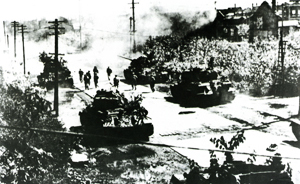 |
| North Korean troops entering
Seoul ? Seoul was captured by North
Korean forces in just three days |
|
Following the division of the Peninsula, two distinct
governments evolved on both sides of the 38th parallel.
Initially, the divide was believed to be only temporary.
However, reunification gradually became an issue
of one side potentially absorbing the other, instilling
hostility on both sides. The Korean War can be interpreted
as the result of a growing desire for reunification,
finally manifesting itself in a violent explosion.
The KPA (Korean People’s Army), which had grown
rapidly under Soviet support, began its invasion
on the morning of June 25, 1950, crossing the 38th
parallel. The KPA overpowered the South Korean Army
in the early stages of the war.
However, following the U.N. resolution to regard
the war as an invasion and to commit troops to stop
it, the tide of the war shifted abruptly. As U.N.
forces kept pushing northward, Korean reunification
seemed within grasp. However, intervention by the
Chinese Army turned the tables again. A stalemate
eventually emerged along the 38th parallel, and
a cease-fire agreement was signed on July 27, 1953. |
|
|
|
 Kim Il-sung Solidifies One-Man Rule
Kim Il-sung Solidifies One-Man Rule |
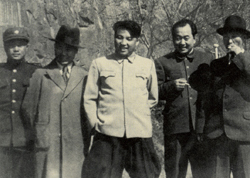 |
| March
1949, at Mt. Keumgang (from the right):
Kim Chaek, Huh Ga-yi, Kim Il-sung |
|
Initially, the North Korean government was a
federation of diverse communist and anti-Japanese
activists such as domestic underground activists,
communist activists who returned from China, and
those who had received communist education in
the Soviet Union. Kim Il-sung, though he enjoyed
little domestic support, was installed as a ‘substitute’
leader of sorts by the Soviet Union in order to
establish a pro-Soviet communist society in North
Korea. Therefore, early political developments
in North Korea involved the gradual solidification
of Kim Il-sung’s authority, which typically involved
eliminating the opposition. First, domestic figures
were labeled as erroneous leftists, factionists,
and hero-centrists and were then eliminated. This
method was used to stifle domestic opposition.
Although Kim Il-sung faced the political responsibility
of having failed in the southward invasion during
the Korean War, he found a way out by blaming
the ‘Namrodang’ (South Korean Worker’s Party),
upon which he eliminated members affiliated with
it. Park Hun-young, Rhee Seung-yup, Bae Chul,
Kim Nam-chun, and others were executed on charges
of U.S.-backed espionage. The indictments of Stalin
raised during the 20th Soviet Communist Party
Assembly meeting led to similar anti-Kim movements
and criticism of the heavy-industry centered economic
policy at the time.
Amid what was likely the most difficult juncture
of his political life, Kim Il-sung succeeded in
winning the June 1956 Party Central Committee
election, upon which he further strengthened his
authority by purging faction leaders (Kim Du-bong,
Choi Chang-ik, Park Chang-ok, etc.).
|
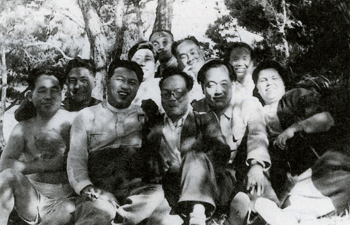 |
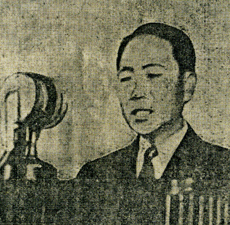 |
Kim
Il-sung’s nemesis, Park Hun-young (man
wearing spectacles)
|
|
| Seung-yup,
closest aide to Park Hun-young and Chairman
of the Provisional People’s Committee
of Seoul City during the Korean War6.25 |
|
|
To complete the purge, those opposed to the
adoration and idolization of Kim Il-sung, as well
as other dissident left-wing opposition leaders,
were the next to be targeted. Some noteworthy
cases include the 1967 elimination of the Gapsan
faction leaders (Park Geum-chul and Rhee Hyo-soon)
on charges of anti-Party factionist movements,
and the 1969 elimination of military leaders (‘People’s
Guardian Minister’ Kim Chang-bong and KPA Political
Bureau Chief Huh Bong-hak) on charges of opposing
Kim’s centralized authority.
Following the 5th KWP (Korea Worker’s Party) assembly
of November 1970, the North Korean leadership
consisted solely of pro-Kim Il-sung members. Kim’s
centralized power and his one-man rule had been
completely solidified. North Korea’s ‘dynastic’
system was founded upon this background.
|
|
|
|
 Construction of a Socialist Economy
Construction of a Socialist Economy |
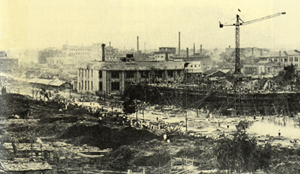 |
| Reconstruction
takes place in Pyongyang amid the ruins
left by the Korean War |
|
Progress in the construction of a socialist economy
was rapid because the process of nationalization
had begun before the government was established,
directly following independence from Japan. The
basis for collective farming was established by
the March 1946 Land Reforms, which involved the
seizure and redistribution of land. In August
of the same year, a law was enacted to nationalize
key factories, firms, mines, power plants, transportation,
the postal service, banking, commerce, and cultural
organizations. Although small-scale economic activity
on the individual level was allowed during the
Korean War in order to make up for low production
levels, most of the economy was nationalized and
collectivized. By 1958, agriculture, handicrafts,
and small-scale commerce were all collectivized,
completing the so-called ‘socialization of production
relations’.
|
|
|
|
| 05 Mar 1946 |
Land Reform Law |
| 10 Aug 1946 |
Nationalization of Key Industries |
| 22 Dec 1946 |
Nationalization of Subterranean Resources,
Forests, and Fisheries |
| Apr 1954 |
Initiation of the ‘cooperative organizations’
system |
| Aug 1958 |
Completion of collective agriculture,
handicrafts, and small-scale commerce |
| Oct~Dec 1958 |
Cooperative organizations consolidated at
town level (reorganized as ‘cooperative farms’ |
|
|
| Cooperative Farms |
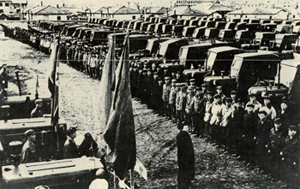 |
| The
completion of agricultural cooperative
organizations prompted North Korea to
focus on modern equipment to boost productivity |
|
Collective agriculture came into full effect
starting at the end of 1953, when ‘cooperative
agricultural organizations’ started to be formed.
Seeing further progress during 1954 and the following
years, by August 1958, all farmers had been registered
as members of a cooperative organization. The
agricultural sector had been completely collectivized.
Initially, there were 13,309 cooperative agricultural
organizations, each consisting of an average of
80 households and 130 ‘chung-bo’ of farmland.
In October 1958, organizations were consolidated
at the town level. The number of organizations
now became 3,843, while each of them was expanded
to include 300 households and 500 ‘chung-bo’ of
farmland. In 1961, parts of the regional and county-level
people’s committees were put in charge of agricultural
management and were reorganized as ‘Cooperative
Agricultural Management Committees’ devoted solely
to directing agricultural activities and operating
agricultural machineries/factories, irrigation
equipment, procurement offices and veterinary
services. The next year, these organizations were
renamed ‘cooperative farms’, completing North
Korea’s cooperative farming system.
|
|
| The Planned Economy
|
Due to the economic policies enacted by the
Japanese colonialists, most power plants and industrial
facilities were located in the northern regions
of the Peninsula. This gave North Korea a huge
initial advantage in building a modern and industrialized
economy. The planned economy system began directly
following independence, before the government
was established.
Two one-year plans were implemented in 1947 and
1948. In 1949, a two-year plan was enacted to
purge industrial sectors of Japanese remnants
and to accelerate production, but was halted due
to the Korean War. In April 1954, it was decided
at the 7th meeting of the 1st SPA that production
be increased to pre-war (1949) levels, and a 3-year
plan for economic recovery was enacted. This plan,
through extensive Chinese and Soviet aid, was
completed successfully four months ahead of schedule.
In 1957, a five-year plan was enacted to lay the
foundations for an industrialized socialist economy
and to provide for the peoples’ clothing, food,
and housing. Again, extensive aid from China,
the Soviet Union, and other communist states enabled
North Korea to achieve its stated objectives two
years ahead of schedule.
|
|
| The Chollima Movement |
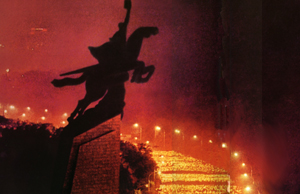 |
| Torchbearers
march by the Chollima statue |
|
The word ‘chollima (thousand-mile horse)’ refers
to a mythical horse that was able to travel a
thousand miles in a single day. The Chollima Movement
was a massive campaign aimed at constructing a
socialist economy at a ‘blindingly quick pace’,
hence the name of the movement. It embodies North
Korea’s style of approach to economic policies:
planned, slogan-oriented, and heavily reliant
on mobilization.
The campaign, enacted on the belief that indoctrinating
workers with communist ideology would lead to
more diligent labor and thus higher production,
was an example of a movement based on so-calleds
‘socialist labor competition.
There had been similar movements aimed at boosting
production before the Chollima Movement, such
as the wartime ‘trooper movement’, ’3.1 memorial
movement’, ‘5.1 memorial movement’, and ‘ever-ready
trooper movement’, as well as the post-war ‘recovery
trooper movement’ and ‘Minchungsoon-hwe victory
flag movement’.
However, the Chollima Movement, enacted in a summary
meeting of the KWP Central Committee held in December
1956, was the first to truly follow the ‘socialist
labor competition’ format. After being adopted
as a general order of the KWP, it was implemented
throughout North Korea along with the five-year
plan that began in 1957. In 1959, it became the
‘Chollima Work Team Movement’, which is said to
have contributed to the early accomplishment of
the five-year plan’s objectives. Until it was
superseded by the ‘Three Revolution Red Flag Movement’
of 1975, the Chollima Movement was the dominant
labor competition movement of the North Korean
society.
|
|
| The Seven-Year Plan |
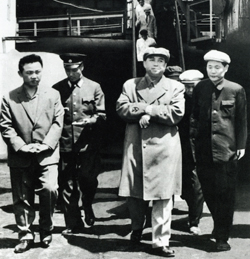 |
| Kim
Il-sung and Kim Jong-il (far left) visit
a steel manufacturing plant in Hwang-hae,
May 1966 |
|
In 1961, North Korea implemented full-scale planned
economy policies based on a socialist economic
system. These include the three seven-year plans,
during which an additional six-year plan was enacted.
The 1st seven-year plan began in 1961 with the
objective of improving the people’s livelihoods
and building on the industrial foundations laid
during the five-year plan of the late 1950s.
At the time, the North Korean economy had reached
a basic level of industrialization through previous
policies emphasizing heavy industries, such as
the manufacture of machinery. However, it quickly
became apparent that industrialization to meet
domestic demand had its limits. Meanwhile, the
Cuban Missile Crisis of October 1962 prompted
the North Korean leadership to fortify its military
capacity. This led to the ‘Four Major Military
Initiatives’, a policy that focused on increasing
military investment.
North Korea found itself in a difficult position
as the rift between China and the Soviet Union
led to curtailed economic aid from socialist states,
causing plans to fall short of their objectives.
The timeline for the seven-year plan was extended
by three years during the October 1966 Party Representatives
Meeting; but the plan nonetheless failed to achieve
its stated goals.
|
|
|
 |
|